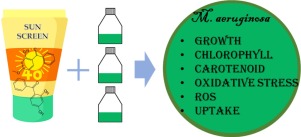当前位置:
X-MOL 学术
›
J. Hazard. Mater.
›
论文详情
Our official English website, www.x-mol.net, welcomes your feedback! (Note: you will need to create a separate account there.)
Antioxidant responses in cyanobacterium Microcystis aeruginosa caused by two commonly used UV filters, benzophenone-1 and benzophenone-3, at environmentally relevant concentrations.
Journal of Hazardous Materials ( IF 13.6 ) Pub Date : 2020-04-02 , DOI: 10.1016/j.jhazmat.2020.122587 Feijian Mao 1 , Yiliang He 2 , Karina Yew-Hoong Gin 3
Journal of Hazardous Materials ( IF 13.6 ) Pub Date : 2020-04-02 , DOI: 10.1016/j.jhazmat.2020.122587 Feijian Mao 1 , Yiliang He 2 , Karina Yew-Hoong Gin 3
Affiliation

|
Benzophenone-type ultraviolet filters (BPs) have recently been recognized as emerging organic contaminants. In the present study, the cyanobacterium Microcystis aeruginosa was exposed to environmentally relevant levels (0.01-1000 μg L-1) of benzophenone-1 (BP-1) and benzophenone-3 (BP-3) for seven days. A battery of tested endpoints associated with photosynthetic pigments and oxidative stress was employed for a better understanding of the mode of action. The tested cyanobacterium could uptake the two BPs (27.4-54.9%) from culture media. The two BPs were able to inhibit the production of chlorophyll a (chl-a) and promote the accumulation of carotenoids, leading to unaffected chl-a autofluorescence. Slightly increased malondialdehyde (MDA) contents suggested that BP-1 and BP-3 caused moderate oxidative stress. BP-1 stimulated the activities of superoxide dismutase (SOD), glutathione reductase (GR) and glutathione S-transferase (GST) in M. aeruginosa while BP-3 increased the activities of SOD, GST, and glutathione (GSH), showing a concentration- and time-dependent relationship. The activities of other biomarkers, such as catalase (CAT) and glutathione peroxidase (GPx) fluctuated depending on exposure time and concentration. The overall results suggested that the two BPs can trigger moderate oxidative stress in M. aeruginosa and the tested cyanobacterium was capable of alleviating stress by different mechanisms.
中文翻译:

在环境相关浓度下,由两种常用的紫外线滤光剂二苯甲酮1和二苯甲酮3引起的铜绿微囊藻中的抗氧化反应。
二苯甲酮型紫外线过滤器(BPs)最近被认为是新兴的有机污染物。在本研究中,铜绿微囊藻暴露于环境相关水平(0.01-1000μgL-1)的二苯甲酮-1(BP-1)和二苯甲酮-3(BP-3)中达七天。使用了一系列与光合色素和氧化应激相关的测试终点,以更好地了解其作用方式。被测试的蓝细菌可以从培养基中摄取两个BP(27.4-54.9%)。这两个BP能够抑制叶绿素a(chl-a)的产生并促进类胡萝卜素的积累,从而导致不受影响的chl-a自发荧光。丙二醛(MDA)含量略有增加表明BP-1和BP-3引起中等程度的氧化应激。BP-1刺激了铜绿假单胞菌中的超氧化物歧化酶(SOD),谷胱甘肽还原酶(GR)和谷胱甘肽S-转移酶(GST)的活性,而BP-3则增加了SOD,GST和谷胱甘肽(GSH)的活性。浓度和时间相关的关系。过氧化氢酶(CAT)和谷胱甘肽过氧化物酶(GPx)等其他生物标志物的活性根据暴露时间和浓度而波动。总体结果表明,两个BP可以触发铜绿假单胞菌中度的氧化应激,并且所测试的蓝细菌能够通过不同的机制缓解应激。过氧化氢酶(CAT)和谷胱甘肽过氧化物酶(GPx)等其他生物标志物的活性根据暴露时间和浓度而波动。总体结果表明,这两个BP可以触发铜绿假单胞菌中度的氧化应激,并且测试的蓝细菌能够通过不同的机制缓解应激。过氧化氢酶(CAT)和谷胱甘肽过氧化物酶(GPx)等其他生物标志物的活性根据暴露时间和浓度而波动。总体结果表明,两个BP可以触发铜绿假单胞菌中度的氧化应激,并且所测试的蓝细菌能够通过不同的机制缓解应激。
更新日期:2020-04-03
中文翻译:

在环境相关浓度下,由两种常用的紫外线滤光剂二苯甲酮1和二苯甲酮3引起的铜绿微囊藻中的抗氧化反应。
二苯甲酮型紫外线过滤器(BPs)最近被认为是新兴的有机污染物。在本研究中,铜绿微囊藻暴露于环境相关水平(0.01-1000μgL-1)的二苯甲酮-1(BP-1)和二苯甲酮-3(BP-3)中达七天。使用了一系列与光合色素和氧化应激相关的测试终点,以更好地了解其作用方式。被测试的蓝细菌可以从培养基中摄取两个BP(27.4-54.9%)。这两个BP能够抑制叶绿素a(chl-a)的产生并促进类胡萝卜素的积累,从而导致不受影响的chl-a自发荧光。丙二醛(MDA)含量略有增加表明BP-1和BP-3引起中等程度的氧化应激。BP-1刺激了铜绿假单胞菌中的超氧化物歧化酶(SOD),谷胱甘肽还原酶(GR)和谷胱甘肽S-转移酶(GST)的活性,而BP-3则增加了SOD,GST和谷胱甘肽(GSH)的活性。浓度和时间相关的关系。过氧化氢酶(CAT)和谷胱甘肽过氧化物酶(GPx)等其他生物标志物的活性根据暴露时间和浓度而波动。总体结果表明,两个BP可以触发铜绿假单胞菌中度的氧化应激,并且所测试的蓝细菌能够通过不同的机制缓解应激。过氧化氢酶(CAT)和谷胱甘肽过氧化物酶(GPx)等其他生物标志物的活性根据暴露时间和浓度而波动。总体结果表明,这两个BP可以触发铜绿假单胞菌中度的氧化应激,并且测试的蓝细菌能够通过不同的机制缓解应激。过氧化氢酶(CAT)和谷胱甘肽过氧化物酶(GPx)等其他生物标志物的活性根据暴露时间和浓度而波动。总体结果表明,两个BP可以触发铜绿假单胞菌中度的氧化应激,并且所测试的蓝细菌能够通过不同的机制缓解应激。



























 京公网安备 11010802027423号
京公网安备 11010802027423号